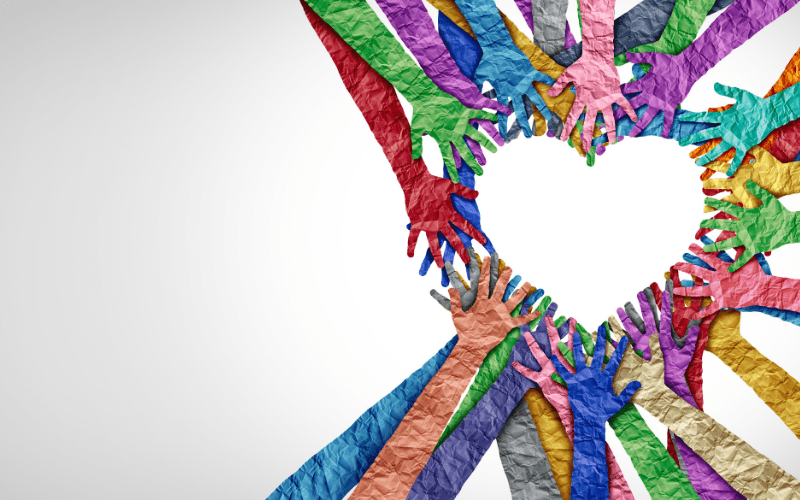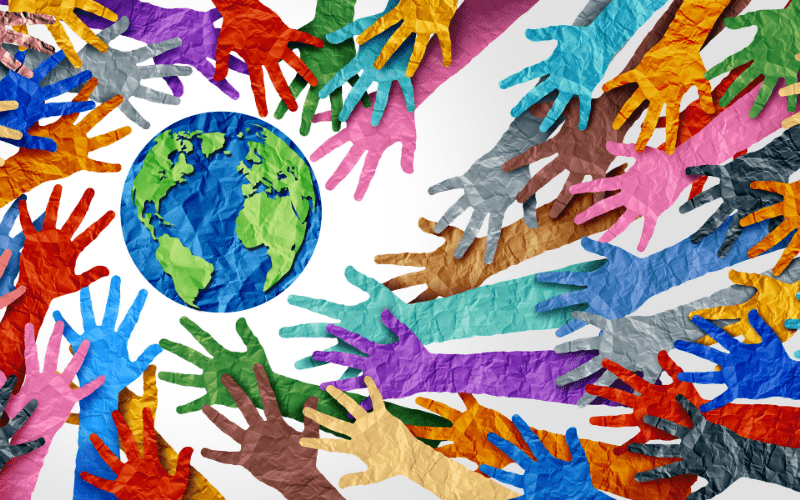July is BIPOC Mental Health Month. We want to continue to feature the importance of confronting oppression dynamics as they can be a big part of any therapy process and relationship. People who identify as Black, Indigenous, and People of Color (BIPOC) are confronted daily with aspects of systemic racism, one of the oppression dynamics in the United States. As part of EMDRIA’s goal of continuing the conversation around the experiences, struggles, and celebrations of BIPOC clients, we asked our members:
“How can EMDR therapists increase the sense of psychological, emotional, and/or physical safety for BIPOC clients?”
“As part of the Institute for Creative Mindfulness BIPOC EMDR training team, we have guided therapist ability to hold space for the complexities of traumas that the BIPOC community has and is presently enduring. We spend extra emphasis on the anti-oppression negative cognitions that are geared to heal the wounds resulting from an oppressive society. This helps therapists increase BIPOC clients’ sense of emotional safety because it is recognizing that we are not trying to deny the damage the oppressive systems are causing, but rather trying to heal the wounds that they are leaving. ” *** Jasmine Adams, LCSW, EMDR Certified and Approved Consultant
“In my work as a bilingual/bicultural clinician serving members of the BIPOC population, I have found that providing a foundation on neuroscience in relation to emotion regulation and distress tolerance is imperative. Developing this understanding while nurturing the client-therapist relationship, naturally gives permission for the therapist to be curious in session while space is created for clients to openly share their cultural/ traditional norms of safety. Together, the client and therapist work to increase a healthy sense of environmental, relational, emotional, and psychological safety.” *** Lilly Alaniz, LCSW
“As a BIPOC woman, therapist, and therapy client, I deal with microaggressions on a daily basis. What I appreciate most is when people are willing to acknowledge and apologize for microaggressions and take time to consider whatever feedback I give them. Don’t assume you know anything about me because of my race. Be curious. Just ask!” *** Anonymous
“EMDR therapists MUST attune to their clients, continue attending EMDR training with different trainers (with different backgrounds/cultures), participate in EMDR consultation (with EMDR therapists from different backgrounds/cultures), and attend to cultural opportunity, meaning, therapists following the client’s cultural statements (e.g., context, beliefs, values). In addition, EMDR therapists need to continue exploring biases (implicit and explicit) and let go of stereotypes within cultures. ALL humans are different and have different experiences and perceptions of the world. Therapists need to be curious about clients’ perceptions of self, others, and the world, and work from the client’s baseline to create psychological, emotional, and physical safety for BIPOC clients.” *** Liliana Baylon, LMFT-S, RPT-S, EMDR Approved Consultant, Bilingual, Bicultural Therapist
“In my experience as a BIPOC individual and a clinician serving BIPOC clients and consultees, the best way to provide safety is to acknowledge and validate the trauma and lack of safety BIPOC individuals face many moments every day. Even if you are not a BIPOC person/therapist, it is important to acknowledge this reality to provide some safety for BIPOC folks whether in day-to-day experiences or in the therapy room. Having this awareness is an ongoing intention and this acknowledgment can bring some safety to the nervous systems/psyche/parts of our clients. Also, not looking to ‘fix’ or heal this trauma as racism exists and is real and is ongoing in our lives and in this world. The nervous systems and our psyches will continue to respond and have a need to protect ourselves. ” *** Alicia Beltran, LCPC, LPC, EMDR Certified, Consultant-in-Training
“Stay authentic, curious, admit shortcomings or lack of knowledge when being curious, be honest, judgement free zone. This works with BIPOC clients, it works with clients of unique cultures that you may not have knowledge about. Invite. Use words like ‘Tell me, what was it like? Who was there for you?’ Openness from the therapist works. Do not assume spiritual values, but do ask. Be adventuresome, search, reinforce and seek resources. Be superficial, egocentric, or fake, and your client will head for the door.” *** Kian F Jacobs, LCSW
“Clinicians can increase BIPOC client safety in many ways. One way is for clinicians to be comfortable with allowing their BIPOC clients space to use or create safety in a way that fits their cultural beliefs. Another way to create safety and increase care it’s important for clinicians to continue to work on their biases around cultural differences and the traditional roles of clinician and client. To increase knowledge there are many free blogs, podcasts, and other social media platforms. There are also paid training clinicians can take to increase their work with BIPOC clients.” *** Brittany A Johnson, LMHC, Approved Consultant
“As a BIPOC EMDR therapist, I increase these aspects by creating understanding from a culture perspective. I educate clients on trauma response from a cultural lens.” *** Ulyssicia Lambert-Coleman (Associate Member)
“I am a Latina woman, first generation and EMDR has changed my life. What was thought to be a normal upbringing, has been termed as ‘cluster traumas’ and this was mind-blowing and life-changing. Safety in general can bring up a lot of memories or connotations for people and through resourcing and somatic work, I find EMDR can be healing in trusting a therapist, to begin with. I specialize in women and trauma and mainly work with BIPOC clients, and psychological and physical safety are two areas that I focus on to do further processing. From personal and professional experience, relearning what safety means is imperative in progress. The beautiful part of my role is to witness other women transform and feel the freedom EMDR brings. ” *** Evelin Lemus, MFT, EMDR Certified Therapist
“Become aware of racism, cultural appropriation, and microaggressions that show up in your space. For example the use of teepees in offices that work with children, culturally appropriated art on walls, mindfulness practices that appropriate culture, etc. Be aware that racial trauma is real and constant. It is hard to feel ‘safe”’in a world that you are not safe in.” *** Kiana Maillet, LCSW
“I think that as EMDR therapists we have to remember what the core of EMDR is about: reprocessing trauma in a safe environment. This includes not just the trauma that we have sustained as a result of interpersonal relationships, but also the trauma sustained as a result of systemic and ongoing oppression. For BIPOC clients, increasing the sense of safety includes the EMDR therapist having more than just a few CE credits about diversity and inclusion under their belt. It also includes the EMDR therapist reckoning with their biases and being open to intentionally dismantling those biases. It also means being open to deliberate practice (a phrase coined by Scott Miller), which is essentially the practice of intentionally learning and growing between sessions with clients. I encourage us to be deliberate when we explore our client’s cultures and educate ourselves with current, reputable sources; be deliberate in our education and learning as we develop the knowledge to hold space for our BIPOC client’s narratives and traumas; be deliberate in our own healing and growth as we also learn how our past can influence the healing journey of our clients. In this deliberate practice, we also develop cultural humility – a sense that we do not know it all and we can allow space for that uncertainty when it comes to learning about others’ cultures. When we work to treat the ongoing trauma and sense of unease that BIPOC clients experience, I implore my fellow EMDR clinicians to use this mantra: I must be more than an ally for my BIPOC clients, I must also be educated, informed, an advocate for justice, and consistently be willing to develop and practice cultural humility. Remember this work is a practice, and it can only grow stronger with intentionality, compassion, knowledge, and the willingness to be uncertain along the way.” *** Mercedes Samudio, LCSW
“This is a really complex question. As an Indigenous person, it’s really important to me that we practice within our scope of work. Because of historical trauma, income disparities, and racial injustice, it’s important that EMDR therapists seek out cultural competency training and supervision from people who live and work with the specific community they are treating. Oftentimes non-BIPOC therapists are not aware of the historical context(s) and lived experience(s) of BIPOC folks. This lack of knowledge may unknowingly contribute to the continued oppression of BIPOC communities in psychotherapy. This creates additional trauma in communities that are already vulnerable to traumatic experiences. The foundation of all good therapy is rapport building. To successfully navigate all 8 phases of EMDR, EMDR therapists should seek proper training, education, and supervision to adequately work with BIPOC communities to learn ways to create safe spaces for BIPOC healing.” *** Jordanna L. Saunders, MC, LPC, NCC, CEAP, Certified EMDR Therapist & Consultant in Training
“EMDR is a specialty that I truly enjoy as a clinician because it allows you to connect with the mind, body, and spirit of a client. For EMDR to be a safe treatment for BIPOC communities, there must be more education around what it is, how it is used, and what to look for in a clinician who is trained (and the difference between the different levels), and what presenting problems it treats. In my practice, I spend a lot of time on history taking and resourcing because I work with clients who have complex traumas. As a result, I do as much as I can to make sure my clients feel safe and ready for the reprocessing phase. I also walk them through each phase as collaboration and continuous rapport-building technique.” *** Djuan Short, LCSW, CTCP, EMDR Certified Therapist
“There are several ways that EMDR therapists can increase the psychological and emotional safety for BIPOC clients. First and foremost, approach your clients with cultural humility. Cultural humility is defined as a “lifelong process of self-reflection and self-critique whereby the individual not only learns about another’s culture, but one starts with an examination of her/his own beliefs and cultural identities.” Cultural humility seeks to cultivate self-awareness on the part of providers and acknowledges the ways in which cultural values and structural forces shape client experiences and opportunities. Therapists should also use broaching with all clients. Broaching refers to the therapist’s efforts to discuss racial, ethnic and cultural issues that are relevant to the client’s presenting concerns. It has been shown to increase counselor credibility, enhance client satisfaction, deepen client disclosure, reduce premature termination rates, and increase clients’ willingness to return for sessions. It is also important not to make assumptions about your BIPOC clients’ experiences. Approach your clients with curiosity and a willingness to understand. And never ask or assume that your clients should educate you rather be intentional about learning on your own.” *** Marisol Solarte-Erlacher, LPC
“As a black female therapist and EMDR consultant, I have the privilege of supporting BIPOC clients and BIPOC clinicians. I believe establishing a sense of safety within the therapeutic relationship is paramount for healing and learning. My approach to establishing security with my clients may vary depending on their race, culture, and identity. This is why I often utilize the Race, Culture, and Identity Interview. This interview can be used in Phase 1 and it gives us the opportunity to gain insight on a deeper level with a holistic and affirming perspective. I also enjoy the ‘Securing Your Space’ resource. With this tool, we can support our BIPOC clients in identifying ways to find security in various environments even when they are unsafe. I have found these resources to be very helpful in addressing various nuances that can create conscious and subconscious barriers to processing.” *** Yunetta Spring Smith, LPC-MHSP, NCC, and EMDRIA Approved Consultant
“Make explicit with visual signs of emotional safety as in poster in your office, disclosure on your website, etc. about being accepting of diversity (if it’s truly being exercised and applies, that is) and continue to elevate EMDR practitioner’s awareness regarding different types of trauma including racial trauma in ongoing training (fundamental and CEUs).” *** Madoka Urhausen, MA, LMFT, ATR-BC (Student Member)
“Many of my BIPOC Clients have never heard of EMDR. I believe that EMDR therapists can do a great deal of support in creating a sense of safety by providing education about EMDR. I never push and sometimes even describe it as ‘trippy’ to normalize that it is completely different than traditional talk therapy and may feel weird. I have found that I’ve had to provide psychoeducation on this therapeutic modality throughout the course of treatment and it is completely normal for clients to question and be skeptical about its effectiveness. The reassurance has allowed me to build trust as folks begin to reprocess some of the most difficult moments of their lives.” *** Leticia Vaca Williams, LCSW, Mexican/Black Clinician
“EMDR desensitizes people from the fight, flight, freeze response created by any trauma/severe stress. EMDR training teaches that there is less of a need for dialog with this therapy modality. BIPOC are more verbal and need to talk through things. As a BIPOC EMDR therapist, I understand this dynamic so allow my BIPOC clients to talk about what was processed. It cultivates a safe place that allows them to understand what is happening psychologically, emotionally, and/or physically as a result of trauma/severe stressors and processing with EMDR. This makes the BIPOC client feel safe, valued, and heard.” *** Renee B. Wilson, MA, LCMHC, NCC, LCAS, RYT (Associate Member)
Resources
American Counseling Association. BIPOC Mental Health Month. https://www.counseling.org/knowledge-center/mental-health-resources/bipoc-mental-health-month
Archer, D. (2020, Fall). Racial trauma, neurons, and EMDR: The path towards antiracist psychotherapy. Go With That Magazine. Open access: www.emdria.org/wp-content/uploads/2021/05/GWT.2020.Vol_.25.Issue_.3.RacialTrauma.ALL_.pdf
Archer, D. (2021). Anti-Racist Psychotherapy: Confronting Systemic Racism and Healing Racial Trauma. Montreal, QC: Each One Teach One Publications.
Ashley, W., & Lipscomb, A. (2020, Fall). Addressing racialized trauma utilizing EMDR and antiracist psychotherapy practices. Go With That Magazine. Open access: www.emdria.org/wp-content/uploads/2021/05/GWT.2020.Vol_.25.Issue_.3.RacialTrauma.ALL_.pdf
Clearly Clinical. (2022). Lifting Black Voices: Therapy, Trust, and Racial Trauma (Ep. 95). Podcast featuring La Shanda Sugg, LPC, Dr. Tiffany Crayton, LPC-S, and LJ Lumpkin, LMFT. https://courses.clearlyclinical.com/courses/free-ceu-racial-trauma-therapy
EMDRIA. Antiracism Resources. www.emdria.org/publications-resources/practice-resources/antiracism-resources/
EMDRIA. Black History, Racial Trauma, and EMDR. Focal Point Blog. https://www.emdria.org/public-resources/black-history-month/
EMDRIA. Diversity and Cultural Competence Association Policy.
EMDRIA. EMDR and Diversity, Community, and Culture Online Community.
EMDRIA. EMDR therapy and parents with Mercedes Samudio, LCSW. Let’s Talk EMDR Podcast Episode 3. https://www.emdria.org/letstalkemdrpodcast/
EMDRIA. EMDR therapy, PTSD and treating black men and adolescents with Dr. Allen Lipscomb. Let’s Talk EMDR Podcast Episode 2. https://www.emdria.org/letstalkemdrpodcast/
Hernandez, C. (2020, Fall). SPACEHOGS make a difference. Go With That Magazine. Open access:www.emdria.org/wp-content/uploads/2021/05/GWT.2020.Vol_.25.Issue_.3.RacialTrauma.ALL_.pdf
Levis, R. V. (2017). Placing Culture at the Heart of EMDR Therapy. In Nickerson, M. I. (Ed.), Cultural Competence and Healing Culturally-Based Trauma with EMDR Therapy: Innovative Strategies and Protocols (pp. 97-112). New York, NY: Springer Publishing Co.
Levis, R. V., & Siniego, L. B. (2017). An Integrative Framework for EMDR Therapy as an Anti-Oppression Endeavor. In Nickerson, M. I. (Ed.), Cultural Competence and Healing Culturally Based Trauma with EMDR Therapy: Innovative Strategies and Protocols (pp. 79-96). New York, NY: Springer Publishing Co.
Mental Health Alliance. Black and African American Communities and Mental Health. www.mhanational.org/issues/black-and-african-american-communities-and-mental-health
National Alliance on Mental Illness (NAMI). Your Journey: Black/African American. www.nami.org/Your-Journey/Identity-and-Cultural-Dimensions/Black-African-American
Nickerson, M. I. (2017). Cultural Competence and Healing Culturally Based Trauma with EMDR Therapy: Innovative Strategies and Protocols. New York, NY: Springer Publishing Co.
Smith, L., Proctor, G., & Akondo, D. (2021). Confronting racism in counselling and therapy training – Three experiences of a seminar on racism and whiteness. Psychotherapy and Politics International, 19(2), e1579. Open access: https://doi.org/10.1002/ppi.1579
The Library of Congress. (n.d.). Black History Month. https://blackhistorymonth.gov/
Urdaneta, V. (2020, Fall). Engage in the conversation of race and racism with “Hot chocolate and cheese:” An idea you can implement. Go With That Magazine. Open access: www.emdria.org/wp-content/uploads/2021/05/GWT.2020.Vol_.25.Issue_.3.RacialTrauma.ALL_.pdf
Washington, J. T. (2020). Examining the historical and present-age impact of racism in the United States of America through the arts, aesthetic education, and transformative learning theory: Empowering social work students to effectively discuss racism and provide best practices with African Americans and other people of color (Publication No. 139) [Doctoral dissertation, University of Pennsylvania, School of Social Work]. https://repository.upenn.edu/edissertations_sp2/139/
EMDRIA Race, Culture, and Ethnicity OnDemand Education Opportunities
Archer, D. (2020). Racial Trauma, Neurons, and EMDR: The Path Towards an Anti-Racist Psychotherapy. [EMDRIA Conference session]. EMDRIA OnDemand. www.emdria.org/course/racial-trauma-neurons-and-emdr-the-path-towards-an-anti-racist-psychotherapy/
Archer, D., Ashley, W., Chaffers, Q., & Hernandez, R. (2020). The Elephant in the Room: Systemic Racism and Psychotherapy. [EMDRIA Conference session, panel discussion]. EMDRIA OnDemand. www.emdria.org/course/the-elephant-in-the-room-systemic-racism-and-psychotherapy/
Ashley, W., & Lipscomb, A. (2020). EMDR Therapy with an Afrocentric Critical Race Perspective. [EMDRIA Conference session]. EMDRIA OnDemand. www.emdria.org/course/emdr-therapy-with-an-afrocentric-critical-race-perspective/
Chaffers, Q., & Brown, K. (2020). Healing the Healer: EMDR-IGTP-OTS & Vicarious Trauma in Black Clinicians. [EMDRIA Conference session]. EMDRIA OnDemand. www.emdria.org/course/healing-the-healer-emdr-igtp-ots-vicarious-trauma-in-black-clinicians/
Hernandez, R. (2020). EMDR Diversity & The Spectrum of Trauma Prevention. [EMDRIA Conference session]. EMDRIA OnDemand. www.emdria.org/course/emdr-diversity-the-spectrum-of-trauma-prevention/
Nickerson, M. (2020). Social Trauma and Adversity: Restoring Connectedness and Resilience. EMDRIA OnDemand. www.emdria.org/course/social-trauma-and-adversity-restoring-connectedness-and-resilience/
Back to Focal Point Blog Homepage
Additional Resources
If you are a therapist interested in the EMDR training:
- Learn more about EMDR at the EMDRIA Library
- Learn more about EMDR Training
- Search for an EMDR Training Provider
- Check out our EMDR Training FAQ
If you are EMDR trained:
- Check out EMDRIA’s Let’s Talk EMDR Podcast
- Check out the EMDRIA blog, Focal Point
- Learn more about EMDRIA membership
- Search for Continuing Education opportunities
If you are an EMDRIA Member:
Date
July 11, 2022
Client Population
Racial/Cultural/Ethnic Groups
Practice & Methods
DEI/IDEA





